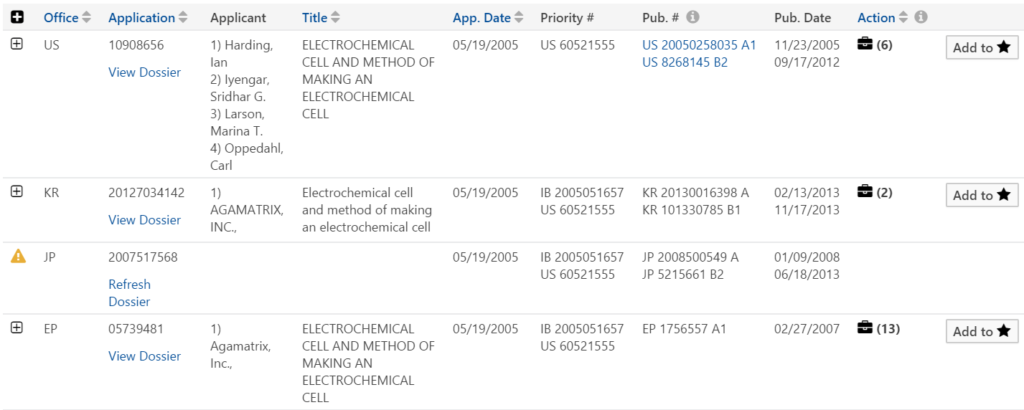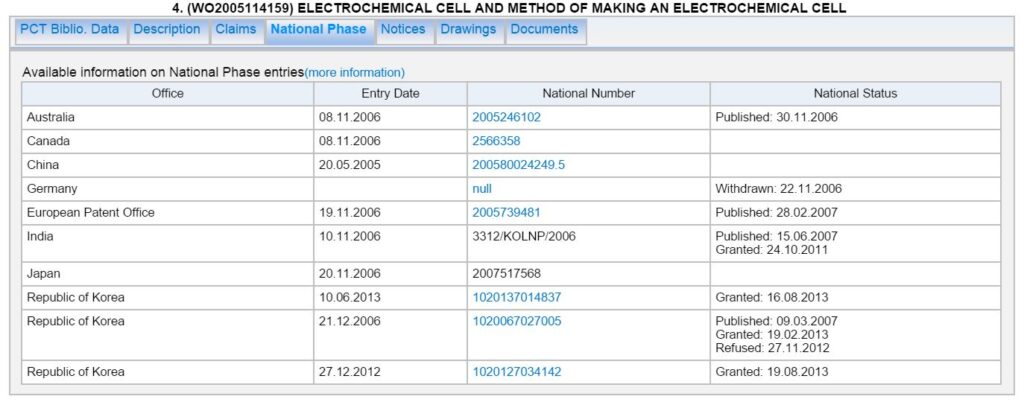(See followup article here.)
Weeks and months ago USPTO delivered webinars and other outre![]() aches in which it demonstrated the soon-to-be-functioning Global Dossier public access system. Today the system got released. You can see it here. Its chief advantage for US filers will be that it will provide English-language access to information in the Japanese, Korean, and Chinese patent office databases.
aches in which it demonstrated the soon-to-be-functioning Global Dossier public access system. Today the system got released. You can see it here. Its chief advantage for US filers will be that it will provide English-language access to information in the Japanese, Korean, and Chinese patent office databases.
I will explain a bit about how it works and what you can do with it.
What is Global Dossier public access (GDPA)? GDPA is sort of like Public PAIR but offers English-language access to patent family information in the IP5 offices and other offices. (The IP5 offices are the patent offices of the US, Japan, Korea, China, and the EPO.) You plug in a patent number, publication number, or application number as your starting point, and it will look up the patent family that includes that starting point. (In this context “patent family” means “patent filings in various countries linked together by a common priority document”.) Having found the patent family members, the system will then provide “deep links” to public databases at the IP5 offices. With each deep link you can see detailed information about one or another of the patent family members. Here is how USPTO describes it:
By using this service, users can see the patent family for a specific application, containing all related applications filed at participating IP Offices, along with the dossier, classification, and citation data for these applications. This service also provides Office Action Indicators to help users identify applications that contain office actions, a Collections View for saving documents and applications for review later on in the session, and the ability to download the documents in an application.
I tried it out just now, plugging in a US application number for a case in which I am a named inventor, and clicking the search button. The new page was a table with forty-seven rows and ten columns. Each row listed one of forty-seven patent family members in this patent family. The columns listed information such as the application number, the title, and recent Office Actions. Here is an excerpt from the table.
The real payoff comes from a link in each row that says “View Dossier”. You can click on “View Dossier” and you can see the documents in a particular US or foreign application, visible in a database hosted by the associated patent office.
Unfortunately at this time of day, the Chinese and Japanese databases were broken, with a status of “down for scheduled maintenance”. Clicking around a bit, I found out what “scheduled maintenance” means:
- The Japanese patent office server goes out of service every Friday at 5PM Eastern and is broken all day every Saturday and all day every Sunday.
- The Korean patent office server goes out of service every Friday at 10PM Eastern and is broken all day every Saturday and starts working again on Sundays at 10AM Eastern.
- The Chinese patent office server goes out of service every Friday at 11PM Eastern and is broken all day every Saturday and starts working again on Sundays at 11AM Eastern.
Alert readers will recognize that WIPO has been offering a somewhat similar service for many years through its Patentscope system. Having found a PCT application of interest in the Patentscope database, you can click on “national phase” and you will reach a page with deep links to various patent office databases around the world. Here is a screen shot from a sample page for that same patent family in which I am a co-inventor:
You can see this yourself and test the links. Click on this WIPO permalink and then click on “national phase” and you can then try out the deep links.
There are some design flaws in USPTO’s Global Dossier public access system.
A first flaw in USPTO’s Global Dossier public access system is that the system is not restful. It is impossible for example to right-click on a link to open it in a new window. The price that you pay for getting to a new page is that you lose the previous page and it may not be easy to get that previous page back.
Related to the failure to be restful is the failure of the USPTO Global Dossier public access system to provide permalinks. The only way to get to a results page is by manually keying or pasting application information into the initial search screen and then performing some manual mouse clicks.
A third flaw in USPTO’s Global Dossier public access system is that the system fails to provide SSL and PFS on the web interface of the system. (I pointed out USPTO’s failure to provide SSL and PFS in a blog article in August of 2014. USPTO has done nothing to remedy these failures since then.)
Many other patent offices avoid these flaws. EPO’s Patent Register for example provides permalinks and SSL. WIPO’s Patentscope and ePCT systems do the same, and also provide PFS.
Despite these flaws, USPTO’s Global Dossier public access system is likely to be helpful and will be better than nothing. In particular it will provide English-language access to information in the Korean, Japanese, and Chinese patent office databases.
Please try out the system and post a comment with your experience.
